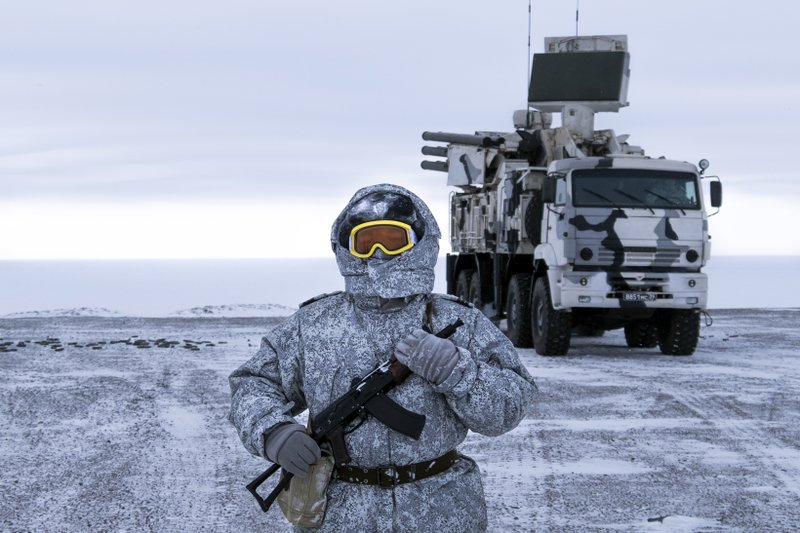SEVERNY KLEVER MILITARY BASE, Russia -- Missile launchers ply icy roads and air defense systems point menacingly into the sky at this Arctic military outpost, a key vantage point for Russia to project its power over the resource-rich polar region.
The base, dubbed Severny Klever (Northern Clover) for its trefoil shape, is painted in the white, blue and red colors of the Russian national flag. It has been designed so soldiers can reach all of its sprawling facilities without venturing outdoors -- a useful precaution in an area where temperatures often plunge to minus 50 Celsius (minus 58 Fahrenheit) during the winter, and even in the short Arctic summer are often freezing at night.
It's strategically located on Kotelny Island, between the Laptev Sea and the East Siberian Sea on the Arctic shipping route, and permanently houses up to 250 military personnel responsible for maintaining air and sea surveillance facilities and coastal defenses like anti-ship missiles.
The Russian base has enough supplies to remain fully autonomous for more than a year.
"Our task is to monitor the airspace and the northern sea route," said base commander Lt. Col. Vladimir Pasechnik. "We have all we need for our service and comfortable living."
Russia is not alone in trying to assert jurisdiction over parts of the Arctic, as shrinking polar ice opens fresh opportunities for resource exploration and new shipping lanes. The United States, Canada, Denmark and Norway are jostling for position, as well, and China also has shown an increasing interest in the polar region.
But while U.S. President Donald Trump's administration has seen the Arctic through the lens of security and economic competition with Russia and China, it has yet to demonstrate that the region is a significant priority in its overall foreign policy. The post of special U.S. representative for the Arctic has remained vacant since Trump assumed office.
Russia, however, has made reaffirming its presence in the Arctic a top goal, not the least because the region is believed to hold up to one-quarter of the Earth's undiscovered oil and gas. Russian President Vladimir Putin has cited estimates that put the value of Arctic mineral riches at $30 trillion.
The move has alarmed Russia's neighbors, analysts say.
"In Russia, the Northern sea route has been described as a bonanza with lots of potential of economic development," said Flemming Splidsboel Hansen of the Danish Institute for International Studies. "And that's why there is a need for military capacity in the area. It is likely meant as defensive, but it is being interpreted by the West as offensive."
Kristian Soeby Kristensen, a researcher at Copenhagen University in Denmark, said the problem of Russian hegemony in the Arctic was most obvious to Norway.
"Norway is a small country, whose next-door neighbor is mighty Russia, which has placed the bulk of its military capacity right next to them," Soeby Kristensen said. "Norway is extraordinarily worried."
In 2015, Russia submitted to the United Nations a revised bid for vast territories in the Arctic. It claimed 1.2 million square kilometers (over 463,000 square miles) of Arctic sea shelf, extending more than 350 nautical miles from the shore.
As part of a multi-pronged effort to stake Russia's claims on the Arctic region, the Kremlin has poured massive resources into modernizing Soviet-era installations there.
The military outpost on Kotelny Island fell into neglect after the 1991 collapse of the Soviet Union, but a massive effort to build a new base began in 2014 and took several years.
A group of reporters brought to the island by the Russian Defense Ministry on Wednesday were shown Bastion anti-ship missile launchers positioned for a drill near the shore and Pantsyr-S1 air defense systems firing shots at a practice target.
International on 04/06/2019